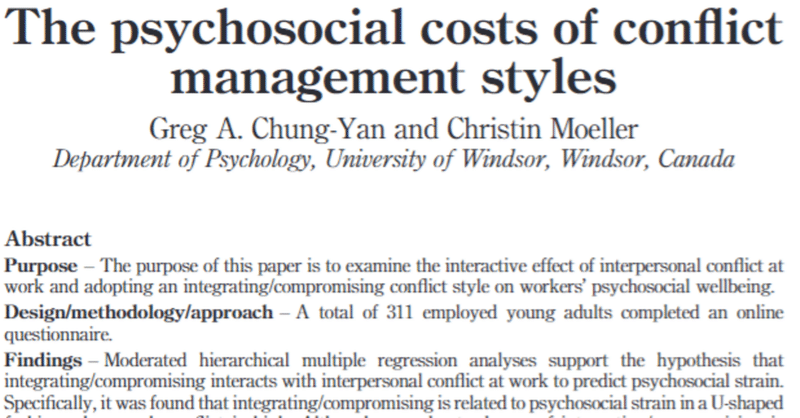
【Integrating/Compromisingな対立マネージメントの頻回の使用は関係性の対立が深いときはアウトカムを増悪させうる】The psychosocial costs of conflict management styles
概要
本研究の目的は、従業員のウェルビーイングに対し、職場の関係性の葛藤とintegrating/compromising対立様式の相互作用が及ぼす影響を明らかにすることである。311名の従業員を対象にオンラインサーベイを実施した。
階層的重回帰分析の結果、職場の対立が強い場合には、integrating/compromisingな対立様式と心理学的なストレインの関係はU型になることが示された
中程度のintegrating/compromisingな対立様式が心理社会的に有効であり、関係性の対立の負の効果を緩和するが、ある時点を超えるとintegrating/compromisingな対立様式は心理学的ストレインを強めることが示された
問題と目的
職場の対立はアブセンティーイズム (Giebels & Janssen, 2005)、パフォーマンス低下 (DeDreu & Weingart, 2003)、抑うつ (Spector & Jex, 1998)、不安 (Spector et al., 2000)、バーンアウトにつながる (van Dierendonck & Mevissen, 2002)
対立マネージメント方法の中で、問題解決と呼ばれるIntegratingな方法と、妥協が最も効果的とされる (Rahim, 2002)
職場の関係性の対立
上司との対立は退職意図を高める (Frone, 2000)
その他は普通の先行研究通り
対立マネージメント
マネージメント方略は主として、統合、譲る、回避、強制、妥協に分類される (Thomas, 1992)
主としてintegrative/compromiseな方略が最も効果的だとされている
仮説:Integrative/compromisingな対立スタイルは、職場の関係性の対立が社会的ディスファンクション・不安・抑うつに及ぼす影響を調整し、特に対立が強い場合には関連性はU字型となる。また、関係性の葛藤が低い (もしくはない) 場合は、integrating/compromisingな対立スタイルとアウトカムの関連は認められない
方法
対象者と手続き
カナダの中規模大学の心理学入門コースに登録して雇用された若者311名が、コース単位取得のためのオンラインアンケートに回答した。そのうち3名は、アンケートを理解していないと報告したため分析から除外した
308名 (女性221名) が最終分析対象者となった (平均年齢19.37歳、ジョブテニュア平均25.66カ月
測定内容
①Integrative/compromising conflict styles at work (Cronshaw ' Jethmalani, 2005)

(ここで重要なのは、Compromising/integratingは、一般的に対立解決方法として望ましいとされている方法だということです)
(一般的に最も望ましいとされる対立解決法の特徴を検証します)
②Interpersonal conflict at work (Spector & Jex, 1998)
職場での関係性の対立の頻度を測定する、5項目5件法のリッカート尺度 (alpha=.82)
③Social dysfunction (Kalliath et al., 2004)
④Anxiety/depression (Kalliath et al., 2004)
⑤属性:年齢、性別、テニュア
結果

職場の対立は、社会的非機能 (r=.16)、不安・抑うつ (r=.20)と相関
社会的非機能に及ぼす影響

階層的重回帰分析の結果、社会的非機能に対して、職場での対立とintegrating/compromisingな対立マネージメント方略の二乗のインタラクションタームの増分妥当性と標準変化域係数の統計学的有意性が示された

integrating/Compromisingな対立マネージメント方略は、対立の程度が低いときは使用するほど社会的非機能を抑制させる
一方で、対立の程度が強い場合は、使用するほど社会的機能を促進させる (U字の関連がある)
Integrating/Compromisingな対立マネージメント方略のモデレーション効果が認められ、中程度から低度の使用によって、関係性の対立が強まっても社会的非機能が生じる程度の増加を抑制させる
不安・抑うつに及ぼす影響

階層的重回帰分析の結果、抑うつ・不安に対して、職場での対立とintegrating/compromisingな対立マネージメント方略の二乗のインタラクションタームの増分妥当性と標準変化域係数の統計学的有意性が示された

integrating/Compromisingな対立マネージメント方略は、対立の程度が低いときは使用するほど抑うつ・不安を抑制させる
一方で、対立の程度が強い場合は、使用するほど抑うつ・不安を促進させる (U字の関連がある)
Integrating/Compromisingな対立マネージメント方略のモデレーション効果が認められ、中程度から低度の使用によって、関係性の対立が強まっても抑うつ・不安が生じる程度の増加を抑制させる
文献
Afzalur Rahim, M. (2002). Toward a theory of managing organizational conflict. International journal of conflict management, 13(3), 206-235.
Chung‐Yan, G. A., & Moeller, C. (2010). The psychosocial costs of conflict management styles. International Journal of Conflict Management, 21(4), 382-399.
Cronshaw, S. F., & Jethmalani, S. (2005). The structure of workplace adaptive skill in a career inexperienced group. Journal of Vocational Behavior, 66(1), 45-65.
De Dreu, C. K., & Weingart, L. R. (2003). Task versus relationship conflict, team performance, and team member satisfaction: a meta-analysis. Journal of applied Psychology, 88(4), 741.
Frone, M. (2000), “Interpersonal conflict at work and psychological outcomes: testing a model among young workers”, Journal of Occupational Health Psychology, Vol. 5 No. 2, pp. 246-55.
Giebels, E. and Janssen, O. (2005), “Conflict stress and reduced wellbeing at work: the buffering effect of third-party help”, European Journal of Work and Organizational Psychology, Vol. 14 No. 2, pp. 137-55.
Kalliath, T.J., O’Driscoll, M.P. and Brough, P. (2004), “A confirmatory factor analysis of the General Health Questionnaire-12”, Stress and Health, Vol. 20 No. 1, pp. 11-20.
Spector, P. E., & Jex, S. M. (1998). Development of four self-report measures of job stressors and strain: interpersonal conflict at work scale, organizational constraints scale, quantitative workload inventory, and physical symptoms inventory. Journal of occupational health psychology, 3(4), 356.
Thomas, K. W. (1992). Conflict and negotiation processes in organizations.
van Dierendonck, D., & Mevissen, N. (2002). Aggressive behavior of passengers, conflict management behavior, and burnout among trolley car drivers. International Journal of Stress Management, 9, 345-355.
この記事が気に入ったらサポートをしてみませんか?
